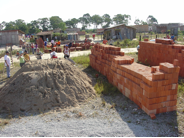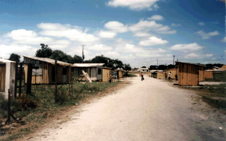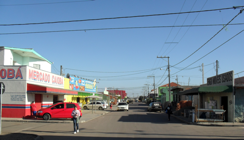Affordable Housing Series: The Rights to the Land Under Your Home
Editor’s Note: NextBillion has launched month-long series on Housing for All in partnership with Ashoka. This special series coincides with two upcoming Ashoka publications on best strategies to achieve Housing for All, Ashoka’s initiatives using its Hybrid Value Chain framework to leverage changes in the affordable housing sector in Brazil, Colombia and India. Please follow the series HERE and Join the discussion with your thoughts and insights. (All photos courtesy of micro home solutions).
The process of global urbanization – with millions migrating from rural areas to find refuge, a new life and hope for a better future – has created disorderly, informal and often chaotic growth. Cities in emerging economies were not prepared for these influxes of people, who come without financial resources to rent a house or skills to find work. As they realize their plight – no place they can afford to live – many have occupied public and private areas illegally, usually in zones ringing the outskirts of cities – without any urban or social infrastructure. These “squatters” may have intended to build temporary shelters until they could get work and rent or build a legal place. But as time passes, they begin adding on to their shelter, trying to make it a “home” for their family. Others join them, and soon squatter communities grow, even though they are built on land that is not legally theirs.
These occupations of vacant lands have become a way to compensate for the affordable housing deficit in many countries. While it solves an immediate problem of shelter, it creates other problems: conflicts over land ownership, urban infrastructure and public services, environmental protection; and conflicts among various government agencies that impact urban development, but do not coordinate with each other. This is all evidence of problems that go beyond that of housing alone.
Informal settlements in Brazil
During the last decades in Brazil, the production of affordable housing has been insufficient.
The 2000 Census in Brazil estimated there were 12.4 million people living in substandard housing. The UN Habitat projects this number will reach 55 million people by 2020. Brazil’s slums, the infamous “favelas,” are growing fast.
Government lags behind the need to solve the integrated problems of affordable housing, especially to resolve issues of rights to the land under the homes new arrivals have built. There has been frequent changes in government policies and programs, conflicting economic and political interests,and just the large amount of resources needed to compensate owners for their land so it can be legally, quickly and fairly transferred to the families and communities that have established homes has become an insurmountable barrier for government to achieve.
Solutions built at the grassroots level
Terra Nova Regularizações Fundiárias, which was established in the southern Brazilian state of Paraná, marks a new, and we believe, unprecedented perspective to solve the lack of land ownership in favelas. Over the past decade, we carefully evaluated the laws defining property rights, and the government’s processes for settling disputes. We found they were overly complex, slow and costly, with the result that slum dwellers rarely used them.
We developed a methodology that significantly reduces the bureaucracy involved in the process of “regularization”(the term the Brazilian government uses to describe the legal and fair transfer of land title from the current private or public land owner to the squatter family or community). This ensures that the conflict related to land ownership is resolved quickly and peacefully, allowing the occupants, with their own resources, to obtain title to the lot in which they reside. To learn more about how the new methodology works please watch the video below:
Results surpassing home and community improvements
By creating an entrepreneurial process whereby families engage in and pay for the process to acquire land rights, the relationship of that person or family to the land is larger than mere ownership. It is a very different and much stronger relationship than when the government gives this title to the residents for free.

Land titling transitions residents from illegal squatters with insecurity about their future and no real “asset” in the homes they build because they lack title, to being able to participate in the formal economy as legal homeowners and community members, now with a tangible, legal asset as collateral. Not surprisingly, we have seen more home improvements after regularization. (Pictured left: Collective work in Vila Marinho to rebuild houses as part of the land title regularization process. Photo: Terra Nova).
From the moment a slum is regularized, the area is recognized by rest of the public (neighbors, public works employees, government agencies) as a legitimate part of the city. Residents begin to enjoy basic services like water, electricity and sewer systems. Residents acquire a formal address. This is more than a detail.  It comes to signify a personal responsibility for the area, which encourages them to invest in improving their property, not contaminating or degrading surrounding property, to act jointly to make the community a cleaner, more healthy and attractive place – all from a sense of pride that ownership conferred. (Pictured right: Squatter community in Curitibia before the transfer of land rights. Photo: Association of Residents).
It comes to signify a personal responsibility for the area, which encourages them to invest in improving their property, not contaminating or degrading surrounding property, to act jointly to make the community a cleaner, more healthy and attractive place – all from a sense of pride that ownership conferred. (Pictured right: Squatter community in Curitibia before the transfer of land rights. Photo: Association of Residents).
This gives a common sense of purpose for residents to become active agents of change. The process fosters community organization and strengthens leadership. Through regularization, slum residents have a different relationship with the environment in which they live. The process of regularization results in social and environmental revitalization.
 Over the course of a decade we have seen that when we unite a community towards a common objective, residents become agents for change. Their new-found confidence after having been a part of the regularization process, then asking public agencies to build infrastructure, or meeting with other residents to solve larger problems or clean up contiguous land where garbage spilled over in the past – were made possible through this process of land regularization. When we enable people to take ownership and do the work of regularization, they become active agents of social and community transformation. (Pictured above: The same Curitibia squatter community soon after land title was secured. Image: Terra Nova).
Over the course of a decade we have seen that when we unite a community towards a common objective, residents become agents for change. Their new-found confidence after having been a part of the regularization process, then asking public agencies to build infrastructure, or meeting with other residents to solve larger problems or clean up contiguous land where garbage spilled over in the past – were made possible through this process of land regularization. When we enable people to take ownership and do the work of regularization, they become active agents of social and community transformation. (Pictured above: The same Curitibia squatter community soon after land title was secured. Image: Terra Nova).
Please like NextBillion on Facebook, follow us on Twitter and/or join our LinkedIn group.
- Categories
- Uncategorized
- Tags
- housing
